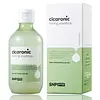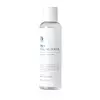What's inside
What's inside
 Key Ingredients
Key Ingredients

 Benefits
Benefits

 Concerns
Concerns

No concerns
 Ingredients Side-by-side
Ingredients Side-by-side

Water
Skin ConditioningDipropylene Glycol
HumectantButylene Glycol
HumectantGlycereth-26
Humectant1,2-Hexanediol
Skin ConditioningPropanediol
SolventGlycereth-25 PCA Isostearate
EmulsifyingGlycerin
HumectantEthylhexylglycerin
Skin ConditioningDiphenyl Dimethicone
EmollientAmmonium Acryloyldimethyltaurate/Vp Copolymer
Triethylhexanoin
MaskingDisodium EDTA
Sodium Hyaluronate
HumectantCentella Asiatica Leaf Extract
Skin ConditioningCentella Asiatica Extract
CleansingMadecassoside
AntioxidantPanthenol
Skin ConditioningPolyglyceryl-10 Oleate
Skin ConditioningBiosaccharide Gum-1
HumectantHydrogenated Lecithin
EmulsifyingHyaluronic Acid
HumectantHydrolyzed Hyaluronic Acid
HumectantFragaria Vesca Leaf Extract
AstringentChamomilla Recutita Flower Extract
MaskingLavandula Angustifolia Flower Extract
CleansingMelissa Officinalis Leaf Extract
Skin ConditioningOriganum Majorana Leaf Extract
AntiseborrhoeicRosmarinus Officinalis Leaf Extract
AntimicrobialSalvia Officinalis Leaf Extract
CleansingThymus Vulgaris Leaf Extract
Skin ProtectingParfum
MaskingWater, Dipropylene Glycol, Butylene Glycol, Glycereth-26, 1,2-Hexanediol, Propanediol, Glycereth-25 PCA Isostearate, Glycerin, Ethylhexylglycerin, Diphenyl Dimethicone, Ammonium Acryloyldimethyltaurate/Vp Copolymer, Triethylhexanoin, Disodium EDTA, Sodium Hyaluronate, Centella Asiatica Leaf Extract, Centella Asiatica Extract, Madecassoside, Panthenol, Polyglyceryl-10 Oleate, Biosaccharide Gum-1, Hydrogenated Lecithin, Hyaluronic Acid, Hydrolyzed Hyaluronic Acid, Fragaria Vesca Leaf Extract, Chamomilla Recutita Flower Extract, Lavandula Angustifolia Flower Extract, Melissa Officinalis Leaf Extract, Origanum Majorana Leaf Extract, Rosmarinus Officinalis Leaf Extract, Salvia Officinalis Leaf Extract, Thymus Vulgaris Leaf Extract, Parfum
Water
Skin ConditioningCentaurea Cyanus Flower Water
Skin ConditioningPentylene Glycol
Skin ConditioningLactobionic Acid
BufferingGlycerin
HumectantSodium PCA
HumectantPropanediol
SolventChrysanthemum Sinense Flower Extract
CleansingOleanolic Acid
Skin ConditioningSodium Hyaluronate
HumectantSodium Gluconate
Skin ConditioningDipotassium Glycyrrhizate
HumectantEnantia Chlorantha Bark Extract
Skin ConditioningCeramide NP
Skin ConditioningAllantoin
Skin ConditioningButylene Glycol
HumectantCaprylic/Capric Triglyceride
MaskingHydrogenated Lecithin
EmulsifyingPhytosteryl/Octyldodecyl Lauroyl Glutamate
Skin ConditioningWater, Centaurea Cyanus Flower Water, Pentylene Glycol, Lactobionic Acid, Glycerin, Sodium PCA, Propanediol, Chrysanthemum Sinense Flower Extract, Oleanolic Acid, Sodium Hyaluronate, Sodium Gluconate, Dipotassium Glycyrrhizate, Enantia Chlorantha Bark Extract, Ceramide NP, Allantoin, Butylene Glycol, Caprylic/Capric Triglyceride, Hydrogenated Lecithin, Phytosteryl/Octyldodecyl Lauroyl Glutamate
 Reviews
Reviews

Ingredients Explained
These ingredients are found in both products.
Ingredients higher up in an ingredient list are typically present in a larger amount.
Butylene Glycol (or BG) is used within cosmetic products for a few different reasons:
Overall, Butylene Glycol is a safe and well-rounded ingredient that works well with other ingredients.
Though this ingredient works well with most skin types, some people with sensitive skin may experience a reaction such as allergic rashes, closed comedones, or itchiness.
Learn more about Butylene GlycolGlycerin is already naturally found in your skin. It helps moisturize and protect your skin.
A study from 2016 found glycerin to be more effective as a humectant than AHAs and hyaluronic acid.
As a humectant, it helps the skin stay hydrated by pulling moisture to your skin. The low molecular weight of glycerin allows it to pull moisture into the deeper layers of your skin.
Hydrated skin improves your skin barrier; Your skin barrier helps protect against irritants and bacteria.
Glycerin has also been found to have antimicrobial and antiviral properties. Due to these properties, glycerin is often used in wound and burn treatments.
In cosmetics, glycerin is usually derived from plants such as soybean or palm. However, it can also be sourced from animals, such as tallow or animal fat.
This ingredient is organic, colorless, odorless, and non-toxic.
Glycerin is the name for this ingredient in American English. British English uses Glycerol/Glycerine.
Learn more about GlycerinHydrogenated Lecithin is created from the hydrogenation of lecithin (a group of phospholipids). Hydrogenation is a chemical reaction between hydrogen and another element.
This ingredient is an emollient and emulsifier. As an emollient, it helps soften skin by trapping moisture within. As an emulsifier, it prevents oil and water ingredients from separating.
Propanediol is an all-star ingredient. It softens, hydrates, and smooths the skin.
It’s often used to:
Propanediol is not likely to cause sensitivity and considered safe to use. It is derived from corn or petroleum with a clear color and no scent.
Learn more about PropanediolSodium Hyaluronate is hyaluronic acid's salt form. It is commonly derived from the sodium salt of hyaluronic acid.
Like hyaluronic acid, it is great at holding water and acts as a humectant. This makes it a great skin hydrating ingredient.
Sodium Hyaluronate is naturally occurring in our bodies and is mostly found in eye fluid and joints.
These are some other common types of Hyaluronic Acid:
Learn more about Sodium HyaluronateWater. It's the most common cosmetic ingredient of all. You'll usually see it at the top of ingredient lists, meaning that it makes up the largest part of the product.
So why is it so popular? Water most often acts as a solvent - this means that it helps dissolve other ingredients into the formulation.
You'll also recognize water as that liquid we all need to stay alive. If you see this, drink a glass of water. Stay hydrated!
Learn more about Water